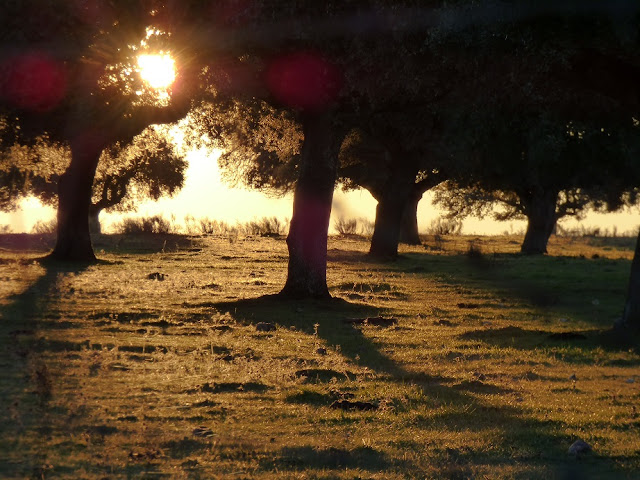Countdown
 |
| Dehesa sunset (Martin Kelsey) |
And yet the recognisable features of December in Extremadura are plain to see and measurable by the milestones I have in place. The first of the winter crane counts took place last week and I spent the morning on my circuit: a slow-paced two hours meander through an astonishing diversity of habitats: stubble fields of rice and maize, wet muddy fields, winter wheat, dehesas, pastures, a reservoir and the edge of pseudosteppe. Each time I found flocks of Common Crane they were counted and their habitat noted. By the end of the morning I had seen over 4,300 birds. Their favoured stubble fields were also the haunts of parties of wintering Grey Lag Geese, one of which also had three Greater White-fronted Geese present as well, much rarer visitors here. Later that day, as the sun set through the near symmetrical architecture of the oaks in dehesa, I counted over 500 cranes flying into a roosting site, in three large bands, their bugling heralding their appearance over the tree-tops.
Two days later I am undertaking my routine twice-winter survey walk through the olives groves close to home. Rising fog impedes visibility slightly, but most of the birds are detected by sound. In two hours 635 encounters take place with a total of 34 species, with Blackcaps being by far the most numerous, 127 in total - wintering birds, attracted along with the Song Thrushes to the heavily ripe olives. Resident birds too like Hawfinches and Azure-winged Magpies feast on these high-energy fruits. A few weeks ago, whilst enjoying a picnic lunch nearby, we watched a large but loose group of Azure-winged Magpies, flying through the open dehesa with their characteristic undulating flight, defining shallow, long arcs and all in a single direction. These birds were truly driven by a purpose, for within five minutes, they reappeared, this time all heading in the diametrically opposite direction, and every one was carrying an olive in its bill, all returning from a group foray in the neighbouring olive field.
 |
| Azure-winged Magpies (John Hawkins) |



Comments